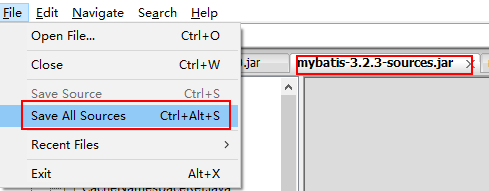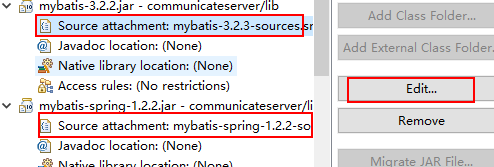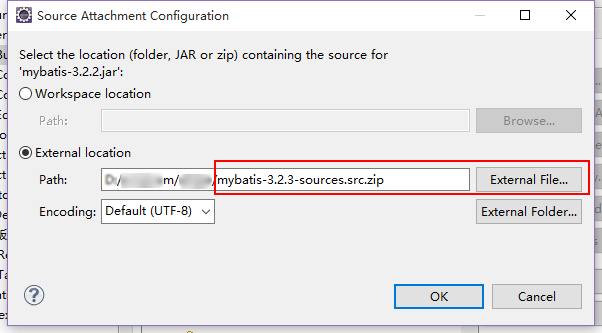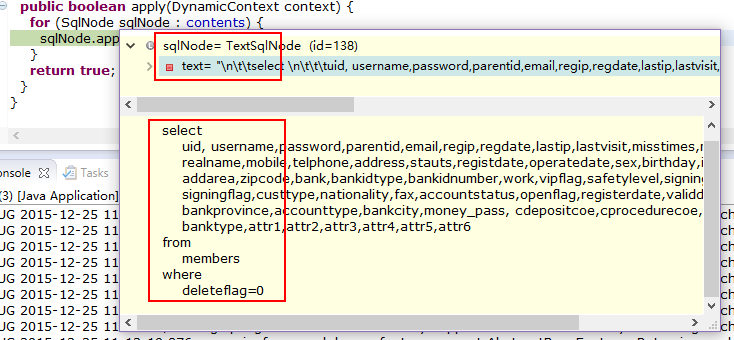springboot整合mybatis——報錯There is no getter for property named '*' in 'class java.lang.String
There is no getter for property named '*' in 'class java.lang.String',此錯誤之所以出現,是因為mybatis在對parameterType="String"的sql語句做了限制,假如你使用<when test="username != null">這樣的條件判斷時,就會出現該錯誤,不過今天我們來刨根問底一下。
一、錯誤再現
想要追本溯源,就需要錯誤再現,那麼假設我們有這樣一個sql查詢:
<select - 1
- 2
- 3
- 4
- 5
- 6
- 7
- 8
- 9
- 10
- 11
parameterType="String",這一點是必須得,引數型別必須是string。- 該sql對應的mapper class中對應的方法為
List<Member> getRiskMember(String username);,也就是說,傳遞的引數名為username,正常情況下,這樣的配置合情合理。 <when test="username != null">,你有一個對應的test判斷語句,也可能是if。- 那麼這個時候,專案執行該查詢語句時,就會丟擲
There is no getter for property named 'username' in 'class java.lang.String'錯誤!
二、解決辦法
當然了,如果你沒有時間來看原始碼分析例項的話,我想先告訴你解決辦法,免得你被問題困擾。解決辦法很簡單,你只需要把 <when test="username != null">修改為 <when test="_parameter!= null">就好了,其他地方不需要改動(也就是說and username = #{username}不需要改動為and username = #{_parameter}),修改後的sql語句如下:
<select id="getRiskMember" resultMap="BaseResultMap" parameterType="String">
<include refid="selectMember"/>
<choose>
<when test="_parameter != null">
and username = #{username}
</when>
<otherwise>
and safetylevel > 1
</otherwise>
</choose>
</select>- 1
- 2
- 3
- 4
- 5
- 6
- 7
- 8
- 9
- 10
- 11
三、原始碼分析
當然了,如果你有時間的話,看一看原始碼分析,或者自己動手嘗試一下,我相信你一定會大有所獲!
①、準備原始碼包
你需要這樣兩個檔案,具體怎麼下載我就不多說了,如果你需要的話,也可以加群120926808:
- mybatis-3.2.3-sources.jar
- mybatis-spring-1.2.2-sources.jar
當然了,你專案中對應的lib包也是相應的版本。
然後,我們把對應的原始碼進行反編譯,生成對應的source,使用的工具是jd-gui.exe。
緊接著,我們來看看如何關聯原始碼包,見下圖:
我已經載入好了,如果是首次的話,可點選edit,在彈出的提示框中選擇上一步儲存的zip檔案。
②、測試用例
準備好原始碼包後,我們來寫一個測試用例,直接main方法就可以,當然了專案不同,方法自然不同,簡單的如下所示:
public static void main(String[] args) throws IOException {
SpringUtils.getSpringContext();
MemberMapper mapper = SpringUtils.getBeansByClassType(MemberMapper.class);
mapper.getRiskMember("00010001");
}- 1
- 2
- 3
- 4
- 5
我們在mapper.getRiskMember("00010001");這行打上斷點。
③、debug除錯
直接執行main方法,在斷點處F5,進入到MapperProxy.java
public Object invoke(Object proxy, Method method, Object[] args) throws Throwable {
if (Object.class.equals(method.getDeclaringClass())) {
return method.invoke(this, args);
}
final MapperMethod mapperMethod = cachedMapperMethod(method);
return mapperMethod.execute(sqlSession, args);
}- 1
- 2
- 3
- 4
- 5
- 6
- 7
可以尾隨debug進入到MapperMethod.java
private <E> Object executeForMany(SqlSession sqlSession, Object[] args) {
List<E> result;
Object param = method.convertArgsToSqlCommandParam(args);
if (method.hasRowBounds()) {
RowBounds rowBounds = method.extractRowBounds(args);
result = sqlSession.<E>selectList(command.getName(), param, rowBounds);
} else {
result = sqlSession.<E>selectList(command.getName(), param);
}
// issue #510 Collections & arrays support
if (!method.getReturnType().isAssignableFrom(result.getClass())) {
if (method.getReturnType().isArray()) {
return convertToArray(result);
} else {
return convertToDeclaredCollection(sqlSession.getConfiguration(), result);
}
}
return result;
}- 1
- 2
- 3
- 4
- 5
- 6
- 7
- 8
- 9
- 10
- 11
- 12
- 13
- 14
- 15
- 16
- 17
- 18
- 19
進入到該方法後,可以一直除錯到result = sqlSession.<E>selectList(command.getName(), param);該行程式碼。此時,你需要按住ctrl鍵,同時點選滑鼠左鍵,見下圖:
在彈出框中選擇open implementation,然後進入到DefaultSqlSession.java
public <E> List<E> selectList(String statement, Object parameter) {
return this.selectList(statement, parameter, RowBounds.DEFAULT);
}- 1
- 2
- 3
在return this.selectList行上打上斷點,然後按F8快捷鍵進入到該方法繼續除錯,(限於篇幅,省略步驟,後續文章中使用…代替)、直到你進入到CachingExecutor.java
public <E> List<E> query(MappedStatement ms, Object parameterObject, RowBounds rowBounds, ResultHandler resultHandler) throws SQLException {
BoundSql boundSql = ms.getBoundSql(parameterObject);
CacheKey key = createCacheKey(ms, parameterObject, rowBounds, boundSql);
return query(ms, parameterObject, rowBounds, resultHandler, key, boundSql);
}- 1
- 2
- 3
- 4
- 5
tips:貓膩就在BoundSql boundSql = ms.getBoundSql(parameterObject);這行程式碼的執行過程中。
(…)(省略步驟,個人除錯過程中請注意。)
直到你進入到DynamicContext.java類時
public DynamicContext(Configuration configuration, Object parameterObject) {
if (parameterObject != null && !(parameterObject instanceof Map)) {
MetaObject metaObject = configuration.newMetaObject(parameterObject);
bindings = new ContextMap(metaObject);
} else {
bindings = new ContextMap(null);
}
bindings.put(PARAMETER_OBJECT_KEY, parameterObject);
bindings.put(DATABASE_ID_KEY, configuration.getDatabaseId());
}- 1
- 2
- 3
- 4
- 5
- 6
- 7
- 8
- 9
- 10
此時,你不妨wait a moment,翻看一下該類的整體程式碼,你會發現:
public static final String PARAMETER_OBJECT_KEY = "_parameter";
public static final String DATABASE_ID_KEY = "_databaseId";- 1
- 2
這裡有兩個常量,當然了,但看此處,也許你會發現"_parameter"這個關鍵字,但這時還說明不了什麼,你且記住bindings.put(PARAMETER_OBJECT_KEY, parameterObject);,同時對ContextMap bindings物件留有一點印象。
key1:_parameter
(…)(省略步驟,個人除錯過程中請注意。)
然後,我們進入MixedSqlNode.java
public boolean apply(DynamicContext context) {
for (SqlNode sqlNode : contents) {
sqlNode.apply(context);
}
return true;
}- 1
- 2
- 3
- 4
- 5
- 6
該apply方法就非常有意思了,xml裡配置的sql語句,會通過該方法轉換為標準的sql(稱之為標準,是值這形成的sql語句就是能夠執行預處理sql查詢的字串),你不妨慢一點執行該迴圈語句。
第二次迴圈的時候,你就可以看到sql的雛形了,那麼請繼續。
(…)(省略步驟,個人除錯過程中請注意。)
直到你發現,sqlNode的型別為ChooseSqlNode,此時,你是否已經能聯想到以下內容:
<choose>
<when test="_parameter != null">- 1
- 2
事情開始變得明朗起來,真好。
(…)(省略步驟,個人除錯過程中請注意。)
繼續除錯,直到你進入到ExpressionEvaluator.java
public boolean evaluateBoolean(String expression, Object parameterObject) {
Object value = OgnlCache.getValue(expression, parameterObject);
if (value instanceof Boolean) return (Boolean) value;
if (value instanceof Number) return !new BigDecimal(String.valueOf(value)).equals(BigDecimal.ZERO);
return value != null;
}- 1
- 2
- 3
- 4
- 5
- 6
- expression的值為
username != null - parameterObject的值為
{_parameter=00010001, _databaseId=null} - 以上兩個引數之間好像有點關係,但離源泉處還差那麼幾步,請繼續。
緊接著,我們進入到OgnlCache.java
public static Object getValue(String expression, Object root) {
try {
return Ognl.getValue(parseExpression(expression), root);
} catch (OgnlException e) {
throw new BuilderException("Error evaluating expression '" + expression + "'. Cause: " + e, e);
}
}- 1
- 2
- 3
- 4
- 5
- 6
- 7
進入到OgnlCache.java
private static Object parseExpression(String expression) throws OgnlException {
try {
Node node = expressionCache.get(expression);
if (node == null) {
node = new OgnlParser(new StringReader(expression)).topLevelExpression();
expressionCache.put(expression, node);
}
return node;
} catch (ParseException e) {
throw new ExpressionSyntaxException(expression, e);
} catch (TokenMgrError e) {
throw new ExpressionSyntaxException(expression, e);
}
}- 1
- 2
- 3
- 4
- 5
- 6
- 7
- 8
- 9
- 10
- 11
- 12
- 13
- 14
key2:
1. parseExpression(expression)的型別為Node,其值為username != null。
2. root的型別為DynamicContext$ContextMap (id=41),其值為{_parameter=00010001, _databaseId=null}
(…)(省略步驟,個人除錯過程中請注意。)
當再繼續執行的話,就回到了DefaultSqlSession.java
public <E> List<E> selectList(String statement, Object parameter, RowBounds rowBounds) {
try {
MappedStatement ms = configuration.getMappedStatement(statement);
List<E> result = executor.query(ms, wrapCollection(parameter), rowBounds, Executor.NO_RESULT_HANDLER);
return result;
} catch (Exception e) {
throw ExceptionFactory.wrapException("Error querying database. Cause: " + e, e);
} finally {
ErrorContext.instance().reset();
}
}- 1
- 2
- 3
- 4
- 5
- 6
- 7
- 8
- 9
- 10
- 11
此時錯誤已經丟擲了,見下圖
到了這,異常是找到怎麼丟擲了,但整體看上來,好像又缺點什麼,沒錯,由於eclipse中無法再看到Ognl.getValue(parseExpression(expression), root);,所以就會造成困擾,我們通過反編譯工具,可以看到getValue方法。
public static Object getValue(Object tree, Object root)
throws OgnlException
{
return getValue(tree, root, null);
}- 1
- 2
- 3
- 4
- 5
public static Object getValue(Object tree, Map context, Object root)
throws OgnlException
{
return getValue(tree, context, root, null);
}- 1
- 2
- 3
- 4
- 5
public static Object getValue(Object tree, Map context, Object root, Class resultType)
throws OgnlException
{
OgnlContext ognlContext = (OgnlContext)addDefaultContext(root, context);
Object result = ((Node)tree).getValue(ognlContext, root);
if (resultType != null) {
result = getTypeConverter(context).convertValue(context, root, null, null, result, resultType);
}
return result;
}- 1
- 2
- 3
- 4
- 5
- 6
- 7
- 8
- 9
- 10
- 11
此時再結合key2給出的內容,我們可以知道,要在{_parameter=00010001, _databaseId=null}匹配到porperty為username的值是不可能的啦,這樣的話,程式就會丟擲org.mybatis.spring.MyBatisSystemException: nested exception is org.apache.ibatis.reflection.ReflectionException: There is no getter for property named 'username' in 'class java.lang.String'錯誤了!
閱讀更多該不該擱下重重的殼,尋找哪裡到底有藍天──周杰倫《蝸牛》 本文出自:【沉默王二的部落格】







